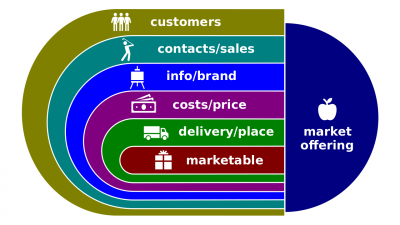Marketable
A marketing mix (alternatively known as product model, marketable compound, and, when already marketed, marketed compound; hereinafter, the Mix) is a model representing distinguishable components of any marketable. In other words, the Mix is a combination of components of a marketable that a business controls in order to influence consumers to purchase this marketable.
Contents
Components
Deliverable
deliverable, which can be divided in an unpackaged deliverable and packaging
Delivery
- Product delivery. The action of delivering marketables either ordered or for sale. Delivery personnel may be incorporated and important for this delivery.
Charge
- Product charge. A payment asked for a marketable. Not only its price, but also financing and acceptable payment methods may be incorporated in and important for this charge.
Presentation
- Product presentation. The proffering or giving of a marketable to its potential consumers, particularly, through product manuals, official website, and public relations. Branding is the marketing practice of creating a name, symbol, or design that identifies and differentiates a marketable from other marketables.
Basic tools
Several business tools are used to capture the Mix in marketing products.
The 4Ps
- Product refers to the deliverable that its seller offers for sale. This may include its features, benefits, style, design, branding, packaging, services, warranties, guarantees, life cycles, investments and returns.
- Price refers to the total cost to customer to acquire the product, and may involve both monetary and psychological costs such as the time and effort spent in acquisition. The product charge such as list pricing, discount pricing, special offer pricing, credit payment or credit terms".
- Place refers either to the physical location where a business carries out business or the distribution channels used to reach markets. They include the direct or indirect channels to market, geographical distribution, territorial coverage, retail outlet, market location, catalogues, inventory, logistics, order fulfillment, virtual stores such as a call center and a website.
- Promotion refers to the marketing communications mix used to make the offer known to potential customers and persuade them to investigate it further.
The 4Cs
- If the 4Ps tool reflects the seller's side, the 4Cs tries to capture the buyer's one:
- Consumer demands as opposed to the product. Consumers buy products to solve particular problems and satisfy particular needs.
- Cost as opposed to the price, which is only a part of the total cost to satisfy customer's demand.
- Convenience as opposed to the place. In the era of Internet, convenience takes into account the ease of buying the product, finding the product, finding information about the product, and several other factors.
- Communication as opposed to the promotion. The buyers look for cooperation rather than manipulation.
The 4As
- Although the 4Cs tool tries to capture the buyer's side, the 4As attempts to capture its drivers:
- Acceptability Acceptability is the extent to which a firm’s total product offering exceeds customer expectations. The authors assert that Acceptability is the dominant component in the framework and that
design, in turn, is at the root of acceptability. Functional aspects of design can be boosted by, for instance, enhancing the core benefit or increasing reliability of the product; psychological acceptability can be improved with changes to brand image, packing and design, and positioning.
- Affordability Affordability is the extent to which customers in the target market are able and willing to pay the product’s price. It has two dimensions:
economic (ability to pay) and psychological (willingness to pay). Acceptability combined with affordability determines the product’s value proposition. When Peachtree Software lowered the price of its accounting software from $5000 to $199 and started charging for customer support, sales demand increased enormously.
- Accessibility Accessibility, the extent to which customers are able to readily
acquire the product, has two dimensions: availability and convenience. Successful companies develop innovative ways to deliver both, as online shoe retailer Zappos does with excellent customer service and return policies and its tracking of up-to-the-minute information about warehouse stock, brands, and styles.
- Awareness Awareness is the extent to which customers are informed regarding the product’s characteristics, persuaded to try it, and reminded to repurchase. It has two dimensions: brand awareness and product knowledge. Sheth and Sisodia say awareness is ripest for improvement because most companies are either ineffectual or inefficient at developing it. For instance, properly done advertising can be incredibly powerful, but word-of-mouth marketing and co-marketing can more effectively reach potential customers. Sheth and Sisodia base the 4 As framework on the four distinctive roles a consumer plays in the marketplace—seeker, buyer, payer, and user. A fifth consumer role—evangelizer—captures the fact that consumers often recommend products to others and are increasingly critical with the advent of the Internet and social media platforms. Note that we can easily relate the 4 As to the traditional 4 Ps. Marketers set the product (which mainly influences acceptability), the price (which mainly influences affordability), the place (which mainly influences accessibility), and promotion (which mainly influences awareness).
Extended tools
The 7Ps
- In addition to the 4P's, the following three P's might be added to describe the Mix of a service,
- People (or personnel) refers to the personnel that stand for the service. In the professional, financial or hospitality service industry, people are not producers, but rather the products themselves.
- Process refers to a set of activities that results in delivery of the product benefits including greetings and customer service actions.
- Physical evidence refers to the tangibles or non-human elements of the service encounter, including equipment, furniture and facilities.
